Petrographic and Geochemical Insights from Fibrous Calcite Veins: Unraveling Overpressure and Fracture Evolution in the Upper Permian Dalong Formation, South China
Abstract
1. Introduction
2. Geological Setting
3. Samples and Methods
4. Results
4.1. Petrographic Characteristics
4.2. Fluid Inclusions
4.3. Trace Elements
4.4. Carbon and Oxygen Isotopes
4.5. LA-ICP-MS In Situ U-Pb Dating
5. Discussion
5.1. Fluid Properties and Sources
5.1.1. Trace Elements as Indicators of Fluid Properties and Origins
5.1.2. Carbon and Oxygen Isotopes as Tracers of Fluid Properties and Sources
5.2. Formation Time of Calcite Veins
5.3. Formation Mechanism of Fibrous Calcite Veins
5.3.1. Material Basis for Vein Formation
5.3.2. Formation of the Median Zone
5.3.3. Growth of Fibrous Calcite
5.4. Geological Significance of Fibrous Calcite Veins for Oil and Gas
6. Conclusions
- (1)
- The fibrous calcite veins in the Dalong Formation, situated in the Jianshi area of Western Hubei, are found in the transitional zone between siliceous and calcareous shales in the central section of the formation and are predominantly composed of antitaxial fibrous calcite veins.
- (2)
- The δ13C values of fibrous calcite veins exhibit a decreasing trend from the median zone toward the directions of fibrous growth. This trend is associated with continuous hydrocarbon generation, wherein CO2 produced during the maturation of organic matter increasingly contributes to the carbon source of the calcite veins. Previous studies have shown that the carbon isotopes of limestones deposited during the Dalong Formation exhibit vertical stability. Consequently, differences in δ13C values among fibrous calcite veins are attributed to variations in the calcareous content of the surrounding rocks and the hydrocarbon generation potential of the shales.
- (3)
- Two distinct types of trace element variations are observed in fibrous calcite veins. One type displays a consistent increase in trace element concentrations from the median zone toward the fibrous growth directions, indicating a single fluid source in a closed environment with a trace element partition coefficient (DTE) of less than 1 between calcite and the aqueous solution. The other type reveals substantial and irregular variations in trace element concentrations, suggesting that the fluids within the fractures are mixtures from multiple layers within the shales. Repeated fracture opening and healing, resulting in vertical shale rupture, are the primary causes of fluid mixing. The median zone and pre-formed veins act as barriers, preventing fluid mixing across the two sides. Variations in δEu values of the fibrous calcite on either side reflect the differences in the compositional makeup and the depositional environment of the surrounding rocks.
- (4)
- In situ U-Pb dating of fibrous calcite veins yields an absolute age of 211 ± 23 Ma, indicating their formation during the Late Triassic. This period aligns with the oil generation window of the Dalong Formation and is consistent with the prevalence of hydrocarbon inclusions within the veins. The formation of fibrous calcite veins is intrinsically linked to the overpressure generated during hydrocarbon maturation.
Author Contributions
Funding
Data Availability Statement
Acknowledgments
Conflicts of Interest
References
- Bons, P.D.; Montenari, M. The formation of antitaxial calcite veins with well-developed fibres, Oppaminda Creek, South Australia. J. Struct. Geol. 2005, 27, 231–248. [Google Scholar] [CrossRef]
- Bons, P.D.; Elburg, M.A.; Gomez-Rivas, E. A review of the formation of tectonic veins and their microstructures. J. Struct. Geol. 2012, 43, 33–62. [Google Scholar] [CrossRef]
- Gasparrini, M.; Lacombe, O.; Rohais, S.; Belkacemi, M.; Euzen, T. Natural mineralized fractures from the Montney-Doig unconventional reservoirs (Western Canada Sedimentary Basin): Timing and controlling factors. Mar. Petrol. Geol. 2021, 124, 104826. [Google Scholar] [CrossRef]
- Peter, C.A.; Zanella, N.; Rodrigues, N.; Løseth, H. Bedding-parallel fibrous veins (beef and cone-in-cone): Worldwide occurrence and possible significance in terms of fluid overpressure, hydrocarbon generation and mineralization. Mar. Petrol. Geol. 2013, 43, 1–20. [Google Scholar]
- Durney, D.; Ramsay, J. Incremental strains measured by syntectonic crystal growths. Gravity Tecton. 1973, 67, 96. [Google Scholar]
- Urai, J.L.; Williams, P.F.; Van Roermund, H.L.M. Kinematics of crystal growth in syntectonic fibrous veins. J. Struct. Geol. 1991, 13, 823–836. [Google Scholar] [CrossRef]
- Hilgers, C.; Urai, J.L. Microstructural observations on natural syntectonic fibrous veins: Implications for the growth process. Tectonophysics 2002, 352, 257–274. [Google Scholar] [CrossRef]
- Wu, A.; Cao, J.; Zhang, J. Bedding-parallel calcite veins indicate hydrocarbon–water–rock interactions in the over-mature Longmaxi shales, Sichuan Basin. Mar. Petrol. Geol. 2021, 133, 105303. [Google Scholar] [CrossRef]
- He, W.; Sun, N.; Zhang, J.; Zhong, J.; Gao, J.; Sheng, P. Genetic mechanism and petroleum geological significance of calcite veins in organic-rich shales of lacustrine basin: A case study of Cretaceous Qingshankou Formation in Songliao Basin, China. Petrol. Explor. Dev. 2024, 51, 1083–1096. [Google Scholar] [CrossRef]
- Wang, M.; Chen, Y.; Song, G.; Steele-MacInnis, M.; Liu, Q.; Wang, X.; Zhang, X.; Zhao, Z.; Liu, W.; Zhang, H.; et al. Formation of bedding-parallel, fibrous calcite veins in laminated source rocks of the Eocene Dongying Depression: A growth model based on petrographic observations. Int. J. Coal Geol. 2018, 200, 18–35. [Google Scholar] [CrossRef]
- Wang, M.; Chen, Y.; Stern, R.A.; Went, A.; Zhou, Y.; Song, G.; Zhou, T. Fibrous calcite veins record stepwise, asymmetric opening and episodic hydrocarbon expulsion from organic-rich shales. Geology 2023, 51, 199–203. [Google Scholar] [CrossRef]
- Zhao, B.; Li, R. Formation mechanism of bedding-parallel antitaxial fibrous veins in shale: A review. J. Struct. Geol. 2022, 161, 104653. [Google Scholar] [CrossRef]
- Zhang, Q.; Ralf, L.; Laura, Z.; Mohammadebrahim, S.; Tang, X.; Zhang, J. Ediacaran, Cambrian, Ordovician, Silurian and Permian shales of the Upper Yangtze Platform, South China: Deposition, thermal maturity and shale gas potential. Int. J. Coal Geol. 2019, 216, 103281. [Google Scholar] [CrossRef]
- Wu, Z.; He, S.; Han, Y.; Zhai, G.; He, X.; Zhou, Z. Effect of organic matter type and maturity on organic matter pore formation of transitional facies shales: A case study on upper Permian Longtan and Dalong shales in Middle Yangtze region, China. J. Earth Sci. 2020, 31, 368–384. [Google Scholar] [CrossRef]
- Wu, Z.; He, S.; He, Z.; Li, X.; Zhai, G.; Huang, Z. Petrographical and geochemical characterization of the Upper Permian Longtan formation and Dalong Formation in the Lower Yangtze region, South China: Implications for provenance, paleoclimate, paleoenvironment and organic matter accumulation mechanisms. Mar. Petrol. Geol. 2022, 139, 105580. [Google Scholar] [CrossRef]
- Hu, D.; Wei, Z.; Wang, W.; Wei, X.; Liu, Z.; Chen, F.; Wei, F.; Li, F. Breakthrough of shale gas exploration in Dalong Formation of Upper Permian by Well Leiye 1 in the northeastern Sichuan Basin and its implications. Nat. Gas Ind. 2023, 43, 28–39. [Google Scholar]
- Song, T.; Li, S.; Zhang, Y.; Ba, H.; Liu, H.; Xu, Q.; Li, H.; Wang, Y.; Wang, Y.; Xie, T.; et al. Gas differential enrichment characteristics and controlling factors of Upper Permian marine shale in western Hubei area: A case study of Wujiaping Formation II in Hongxing block and Dalong Formation in Enshi area. Nat. Gas Geosci. 2023, 34, 1425–1441. [Google Scholar]
- Zhuo, J.; Wang, J.; Wang, Z. Sedimentary characteristics of Late Permian in Western Hubei Province and evolution of inter-platform rift. Xinjiang Petrol. Geol. 2009, 30, 300–303, (In Chinese with English Abstract). [Google Scholar]
- Mao, L.; Xiao, A.; Wei, G. Distribution and origin of the Late Paleozoic-Mesozoic rift systems in the northern margin of the Yangtze block. Acta Geol. Sin. 2011, 27, 721–731, (In Chinese with English Abstract). [Google Scholar]
- Yu, H.; Chen, D.Z.; Wei, H.Y.; Wang, J.G. Origin of bedded chert and organic matter accumulation in the Dalong Formation of Upper Permian in western Hubei Province. Acta Petrol. Sin. 2012, 28, 1017–1027, (In Chinese with English Abstract). [Google Scholar]
- Niu, Z.; Duan, Q.; Xu, A.; Fu, T.; Zeng, B.; Zhu, Y. Discussion on sedimentary environment of Dalong Formation in Jianshi, Western Hubei. Geol. Miner. Resour. South China 1999, 1, 18–23, (In Chinese with English Abstract). [Google Scholar]
- Fu, Y.; Zhang, P.; Li, Z.; Yang, Z.; Liu, X.; Wang, S. The tectonic characteristics and their significance for hydrocarbon exploration in Mid-Yangtze area. Geotecton. Metallog. 2007, 31, 308–314. [Google Scholar]
- Yan, D.; Zhou, M.; Song, H.; Wang, X.; John, M. Origin and tectonic significance of a Mesozoic multi-layer over-thrust system within the Yangtze Block (South China). Tectonophysics 2003, 361, 239–254. [Google Scholar] [CrossRef]
- Woodhead, J.D.; Hergt, J.M. Strontium, neodymium and lead isotope analyses of NIST glass certified reference materials: SRM 610, 612, 614. Geostand. Newsl. 2001, 25, 261–266. [Google Scholar] [CrossRef]
- Su, A.; Chen, H.; Feng, Y.X.; Zhao, J.X.; Nguyen, A.D.; Wang, Z.; Long, X. Dating and characterizing primary gas accumulation in Precambrian dolomite reservoirs, Central Sichuan Basin, China: Insights from pyrobitumen Re-Os and dolomite U-Pb geochronology. Precambrian Res. 2020, 350, 105897. [Google Scholar] [CrossRef]
- Ludwig, K.R. User’s manual for Isoplot 3.75: A geochronological toolkit for Microsoft Excel. Berkeley Geochronol. Cent. Spec. Publ. 2012, 5, 75. [Google Scholar]
- Paton, C.; Hellstrom, J.; Paul, B.; Woodhead, J.; Hergt, J. Iolite: Freeware for the visualization and processing of mass spectrometric data. J. Anal. At. Spectrom. 2011, 26, 2508–2518. [Google Scholar] [CrossRef]
- Mei, L.; Liu, Z.; Tang, J.; Shen, C.; Fan, Y. Mesozoic intra-continental progressive deformation in Western Hunan-Hubei-Eastern Sichuan Provinces of China: Evidence from apatite fission track and balanced cross-section. Earth Sci. 2010, 35, 161–174. [Google Scholar]
- Huang, D.Y. Jurassic integrative stratigraphy and timescale of China. Sci. China Earth Sci. 2019, 62, 223–255. [Google Scholar] [CrossRef]
- Tong, J.N.; Chu, D.L.; Liang, L.; Shu, W.C.; Song, H.J.; Song, T.; Song, H.Y.; Wu, Y.Y. Triassic integrative stratigraphy and timescale of China. Sci. China Earth Sci. 2019, 62, 189–222. [Google Scholar] [CrossRef]
- Liu, D.; Dai, J.; Xiao, X.; Tian, H.; Yang, C.; Hu, A.; Mi, J.; Song, Z. High density methane inclusions in Puguang gasfield: Discovery and a T-P genetic study. Chin. Sci. Bull. 2009, 54, 4714–4723. [Google Scholar] [CrossRef]
- Worden, R.H.; Benshatwan, M.S.; Potts, G.J.L. Basin-scale fluid movement patterns revealed by veins: Wessex Basin, UK. Geofluids 2015, 16, 149–174. [Google Scholar] [CrossRef]
- Shen, S.; Payne, J.; Cao, C.; Davydov, V.; Zhang, H.; Yuan, D.X. High-resolution δ13C carb chemostratigraphy from latest Guadalupian through earliest Triassic in South China and Iran. Earth Planet. Sci. Lett. 2013, 375, 156–165. [Google Scholar] [CrossRef]
- Emery, D.; Robinson, A.G. Inorganic Geochemistry: Applications to Petroleum Geology; Blackwell Scientific Publications: Oxford, UK, 1993. [Google Scholar]
- Liang, C.; Wang, J.; Cao, Y.; Xiong, Z.; Liu, K.; Hao, F.; Han, W. Authigenic calcite in shales: Implications for tracing burial processes and diagenetic fluid evolution in sedimentary basins. Earth-Sci. Rev. 2024, 258, 104935. [Google Scholar] [CrossRef]
- Erel, Y.; Katz, A. Trace-element distribution across calcite veins: A tool for genetic interpretation. Chem. Geol. 1990, 85, 361–367. [Google Scholar] [CrossRef]
- Barker, S.L.L.; Cox, S.F.; Eggins, S.M. Microchemical evidence for episodic growth of antitaxial veins during fracture-controlled fluid flow. Earth Planet. Sci. Lett. 2006, 250, 331–344. [Google Scholar] [CrossRef]
- Veizer, J. Chemical diagenesis of carbonates: Theory and application of trace element technique. In Stable Isotopes in Sedimentary Geology: Short Course; Arthur, M.A., Anderson, T.F., Kaplan, I.R., Veizer, J., Land, L.S., Eds.; Carleton Centre for Geosciences Studies: Ottowa, ON, Canada, 1983; Volume 10, pp. 1–39. [Google Scholar] [CrossRef]
- Lee, S.G.; Lee, D.H.; Kim, Y. Rare earth elements as indicators of groundwater environment changes in a fractured rock system: Evidence from fracture-filling calcite. Appl. Geochem. 2003, 18, 135–143. [Google Scholar] [CrossRef]
- Wang, X.; Mou, C.; Xiao, Z.; Zheng, B.; Chen, Y.; Wang, Q.; Liu, W. Genesis of black rock series of Upper Permian Dalong Formation in Hefeng area, Hubei province: An evidence from the analysis of element geochemistry in Well HD1. Acta Petrol. Sin. 2018, 39, 1355–1369. [Google Scholar]
- Chen, L.; Zhang, B.; Chen, X.; Jiang, S.; Zhang, G.; Lin, W.; Chen, P.; Liu, Z. Depositional environment and organic matter accumulation of the Lower Cambrian Shuijingtuo Formation in the Middle Yangtze Area, China. J. Petrol. Sci. Eng. 2022, 208, 109339. [Google Scholar] [CrossRef]
- Bau, M.; Miller, P. Rare earth element fractionation in metamorphogenic hydrothermal calcite, magnesite and siderite. Mineral. Petrol. 1992, 45, 231–246. [Google Scholar] [CrossRef]
- Bau, M.; Balan, S.; Schmidt, K.; Koschinsky, A. Rare earth elements in mussel shells of the Mytilidae family as tracers for hidden and fossil high-temperature hydrothermal systems. Earth Planet. Sci. Lett. 2010, 299, 310–316. [Google Scholar] [CrossRef]
- Robbins, L.J.; Lalonde, S.V.; Planavsky, N.J.; Partin, C.A.; Reinhard, C.T.; Kendall, B.; Scott, C.; Hardisty, D.S.; Gill, B.C.; Alessi, D.S.; et al. Trace elements at the intersection of marine biological and geochemical evolution. Earth-Sci. Rev. 2016, 163, 323–348. [Google Scholar] [CrossRef]
- Xu, L.; Huang, S.; Liu, D.; Liao, Z.; Wu, K.; Chen, M.; Zhou, X.; Zhang, Y.; Liu, B.; Li, M. Extensive accumulation of organic matter in the Late Permian Dalong Formation, Western Hubei Trough, Southern China. Int. J. Coal Geol. 2025, 302, 104727. [Google Scholar] [CrossRef]
- Zheng, A.; Meng, Z.; Li, K. Vertical heterogeneity characteristics and main controlling factors of the Permian Wujiaping Formation shale reservoir in Hongxing area, eastern Sichuan. Nat. Gas Geosci. 2023, 34, 1500–1514. [Google Scholar]
- Myrttinen, A.; Becker, V.; Barth, J. A review of methods used for equilibrium isotope fractionation investigations between dissolved inorganic carbon and CO2. Earth-Sci. Rev. 2012, 115, 192–199. [Google Scholar] [CrossRef]
- Conliffe, J.; Azmy, K.; Gleeson, S.A.; Lavoie, D. Fluids associated with hydrothermal dolomitization in St. George Group, western Newfoundland, Canada. Mar. Petrol. Geol. 2010, 30, 161–173. [Google Scholar] [CrossRef]
- Chen, Y.N.; Zhang, J.Y.; Li, W.Z.; Pan, L.Y.; She, M. Lithofacies paleogeography, reservoir origin and distribution of the Cambrian Longwangmiao Formation in Sichuan Basin. Mar. Orig. Pet. Geol. 2020, 25, 171–180. [Google Scholar]
- Hooker, J.N.; Ruhl, M.; Dickson, A.J. Shale anisotropy and natural hydraulic fracture propagation: An example from the Jurassic (Toarcian) Posidonienschiefer, Germany. J. Geophys. Res. Solid Earth 2020, 125, e2019JB018442. [Google Scholar] [CrossRef]
- Osborne, M.; Swarbrick, R. Mechanisms for generating overpressure in sedimentary basins: A reevaluation. AAPG Bull. 1997, 81, 1023–1041. [Google Scholar] [CrossRef]
- Zhou, X.; Xu, L.; Wen, Y.; Liu, Z.; Chen, C.; Luo, F. Reservoir characteristics and sedimentary environment of Permian Dalong Formation in Jianshi-Changyang area of western Hubei Province. Geol. Miner. Resour. South China 2019, 35, 244–253. [Google Scholar]
- Liu, S.; Wang, P.; Hu, M. Evolution and geodynamic mechanism of basin-mountain systems in the northern margin of the Middle-Upper Yangtze. Earth Sci. Front. 2010, 17, 14–26. [Google Scholar]
- Chen, L.; Zhang, B.; Jiang, S.; Chen, X.; Zhang, G.; Chen, P.; Lin, W.; Liu, Z. Geochemical characteristics of the Upper Devonian Shetianqiao Formation in the Shaoyang Sag of Xiangzhong Depression from Middle Yangtze Area, South China: Implications for the depositional environment and organic matter enrichment. Palaeogeogr. Palaeoclimatol. Palaeoecol. 2021, 574, 110448. [Google Scholar] [CrossRef]
- Kamp, P.C.V.D. Smectite-Illite-Muscovite transformations, quartz dissolution, and silica release in shales. Clays Clay Miner. 2008, 56, 66–81. [Google Scholar] [CrossRef]
- Surdam, R.C.; Boese, S.W.; Crossey, L.J. The chemistry of secondary porosity. AAPG Mem. 1984, 34, 127–149. [Google Scholar]
- Su, A.; Bons, P.D.; Chen, H.; Feng, Y.X.; Zhao, J.X.; Song, J. Age, material source, and formation mechanism of bedding-parallel calcite beef veins: Case from the mature Eocene lacustrine shales in the Biyang Sag, Nanxiang Basin, China. Geol. Soc. Am. Bull. 2022, 134, 1811–1833. [Google Scholar] [CrossRef]
- Mügge, O. Über die Entstehung faseriger Minerale und ihrer Aggregationsformen. Neues Jahrb. Mineral. Geol. Paläontol. A 1928, 58, 1–28. [Google Scholar]
- Ramsay, J.G. The crack-seal mechanism of rock deformation. Nature 1980, 284, 135–139. [Google Scholar] [CrossRef]
- Hao, F.; Zou, H.; Lu, Y. Mechanisms of shale gas storage: Implications for shale gas exploration in China. AAPG Bull. 2013, 97, 1325–1346. [Google Scholar] [CrossRef]
- Nie, H.; He, Z.; Wang, R.; Zhang, G.; Chen, Q.; Li, D.; Lu, Z.; Sun, C. Temperature and origin of fluid inclusions in shale veins of Wufeng–Longmaxi Formations, Sichuan Basin, south China: Implications for shale gas preservation and enrichment. J. Petrol. Sci. Eng. 2020, 193, 1–18. [Google Scholar] [CrossRef]
- Zhang, J.; Jiang, Z.; Wang, S.; Wang, R.; Zhang, Y.; Du, W. Bedding-parallel calcite veins as a proxy for shale reservoir quality. Mar. Petrol. Geol. 2021, 127, 104975. [Google Scholar] [CrossRef]

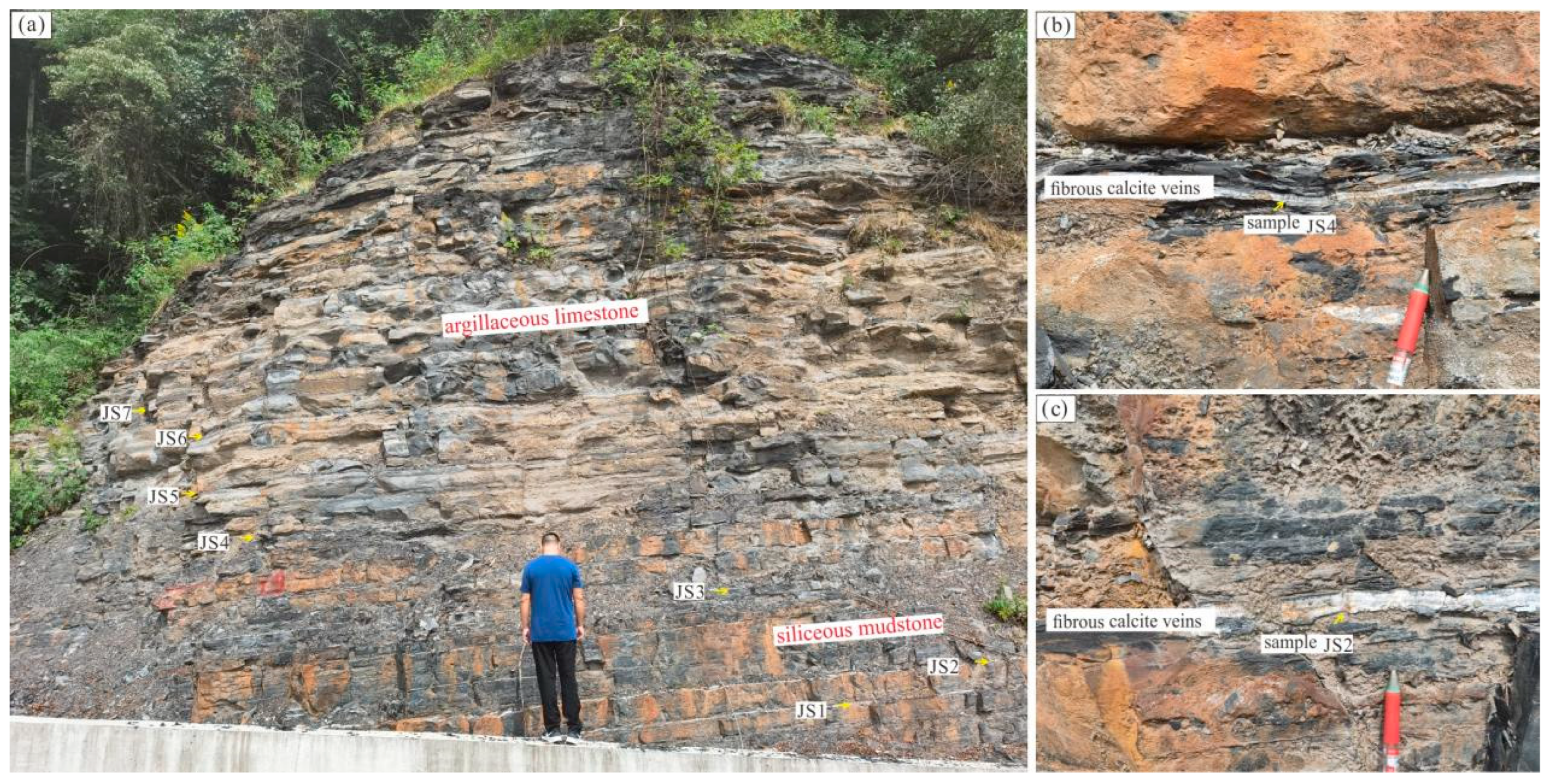
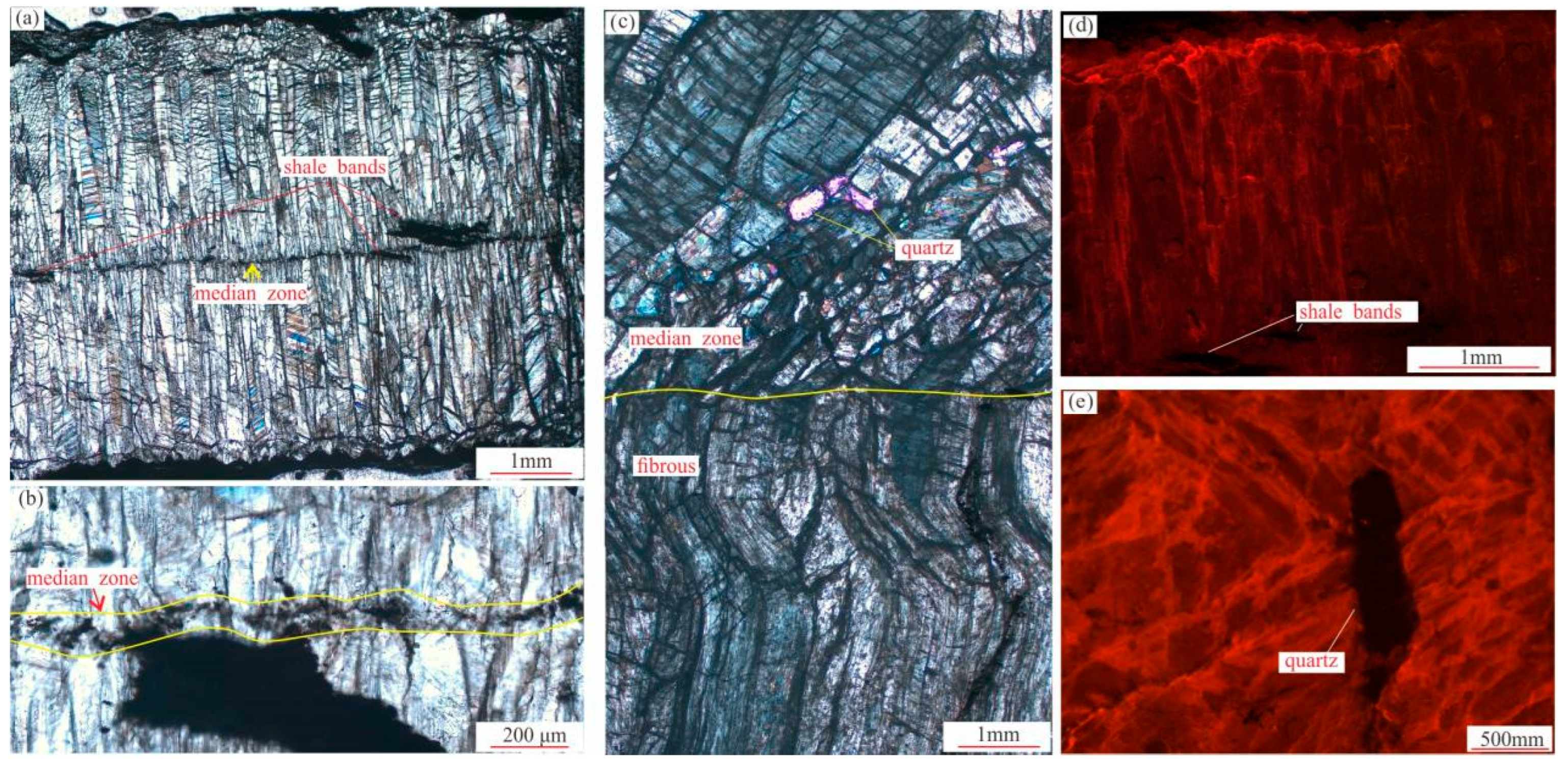
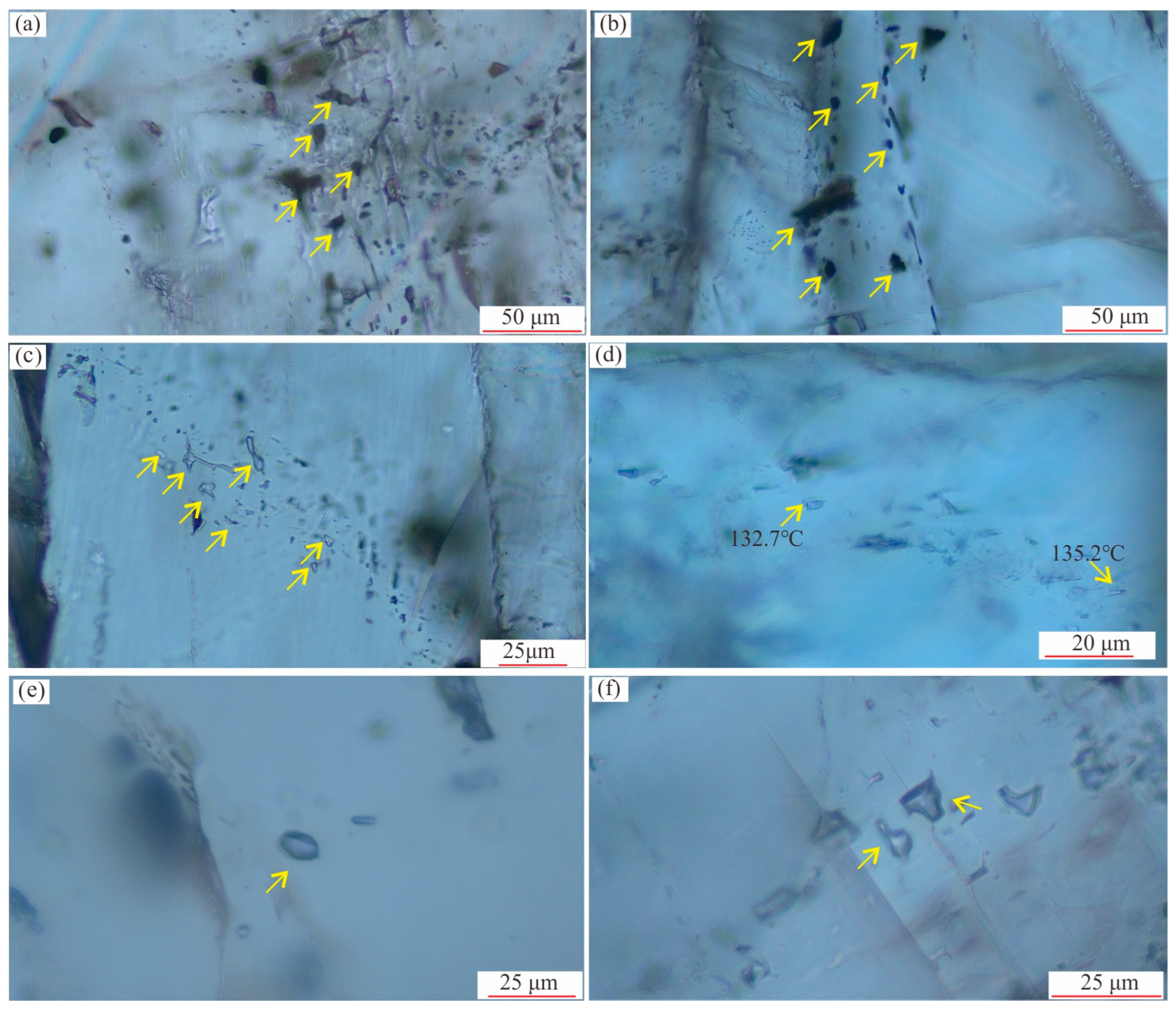
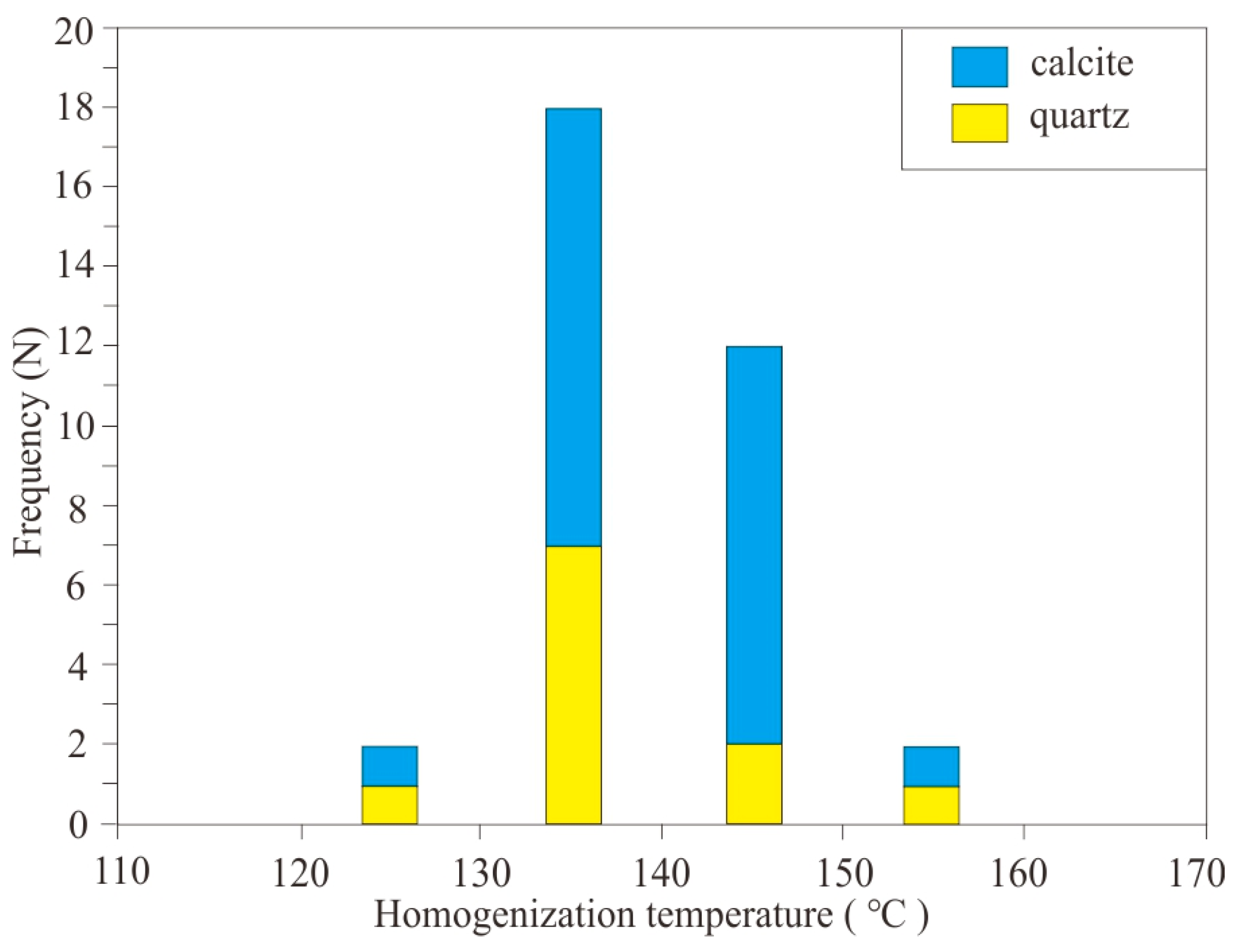
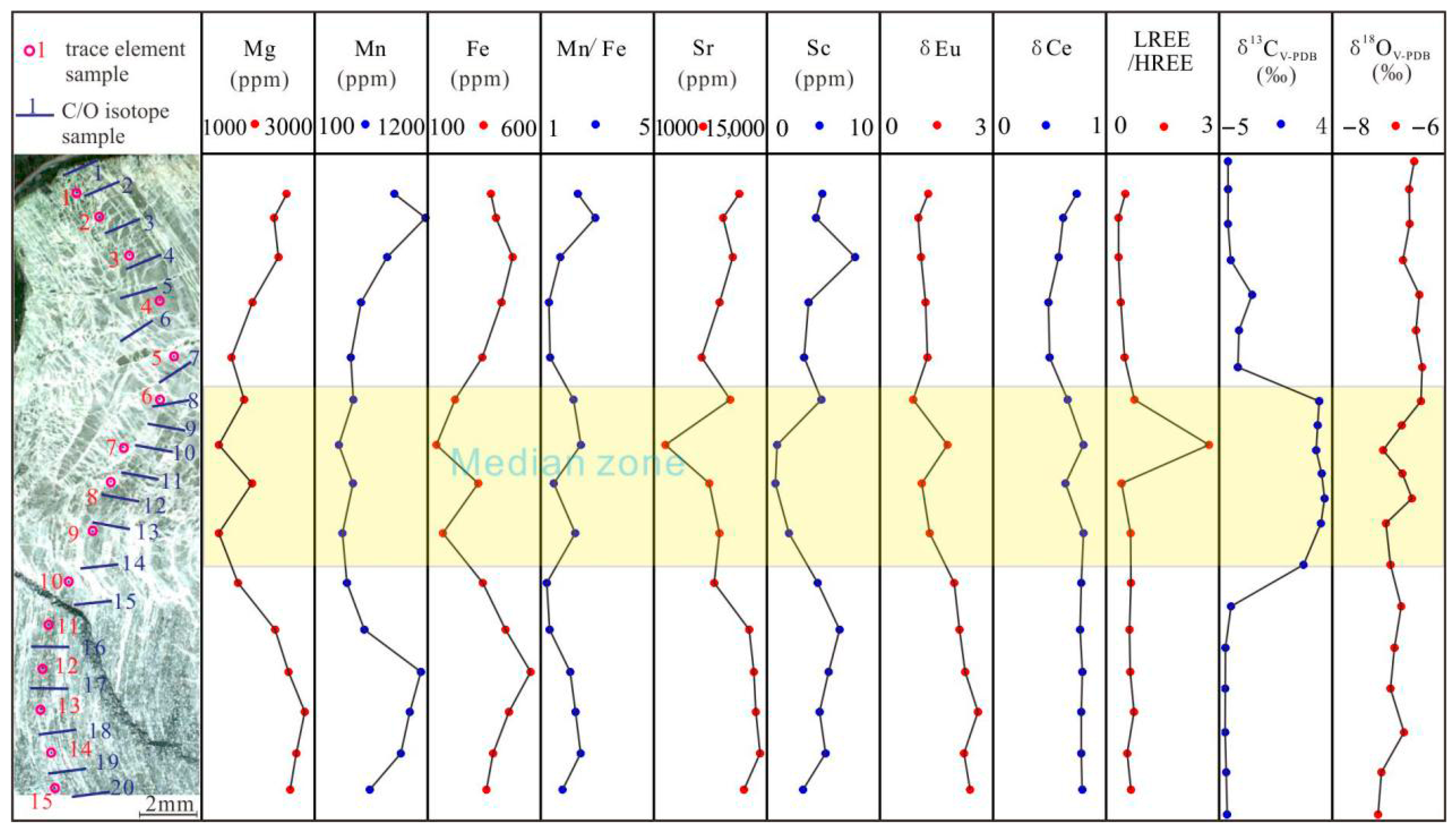
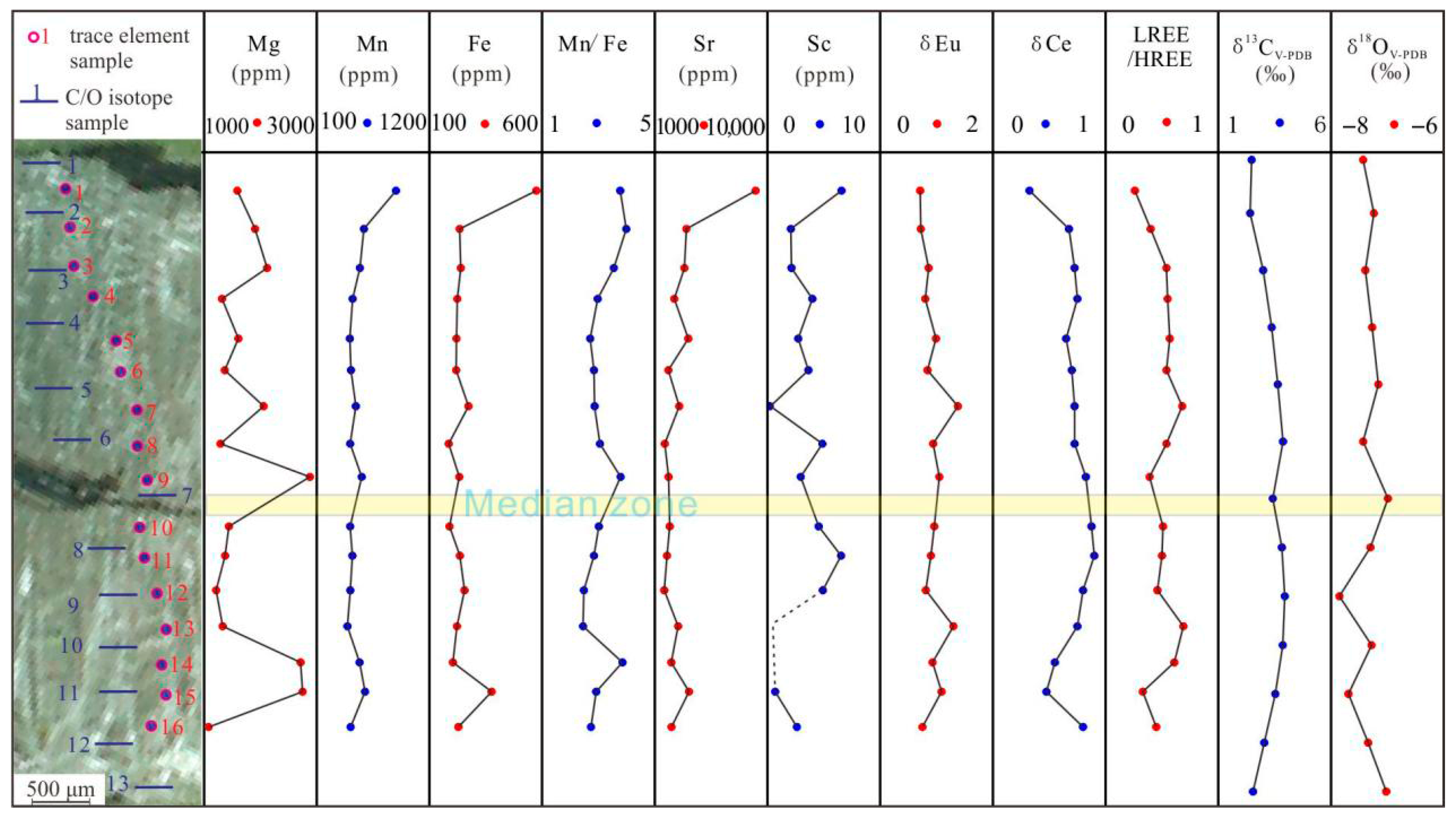
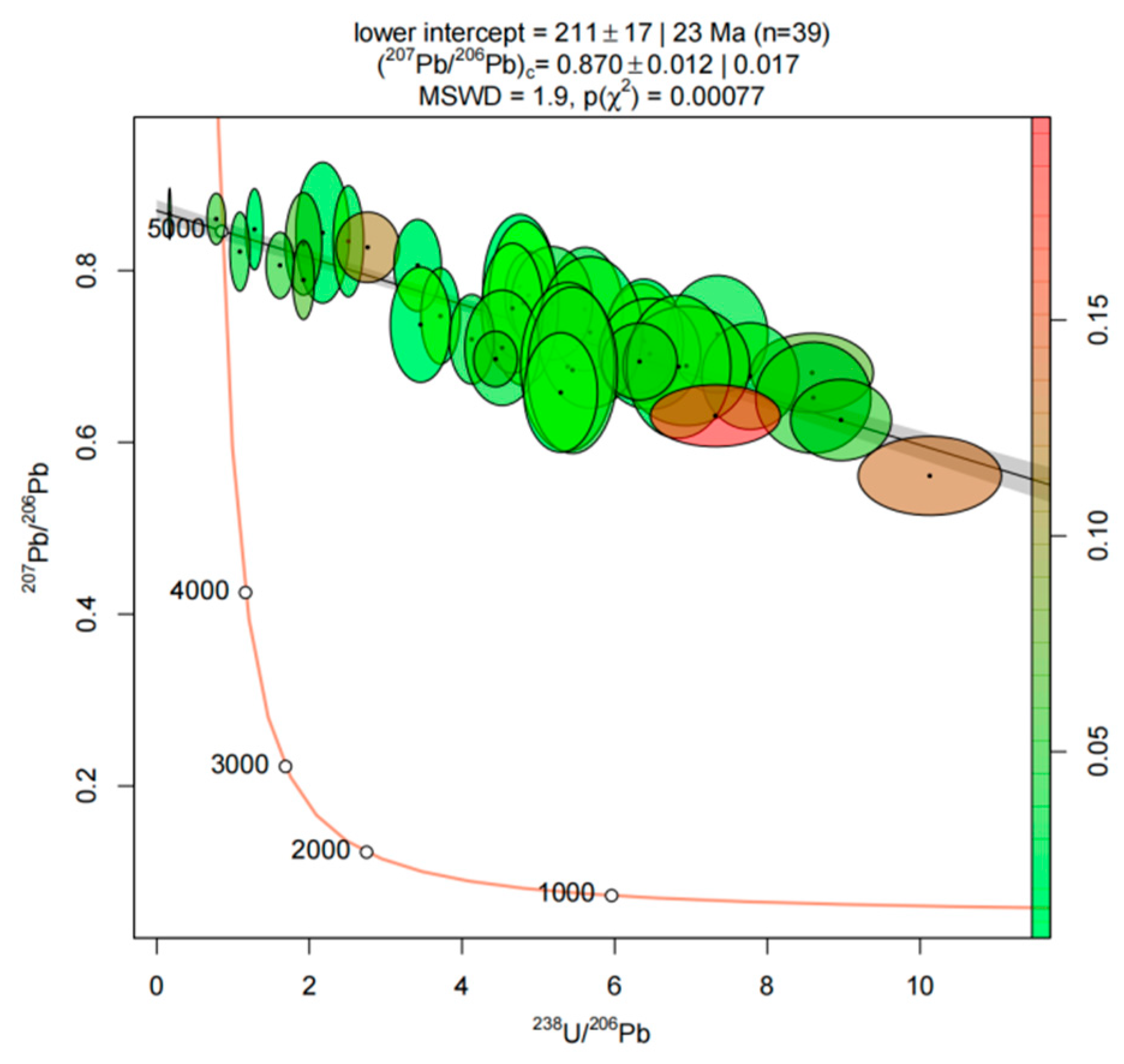

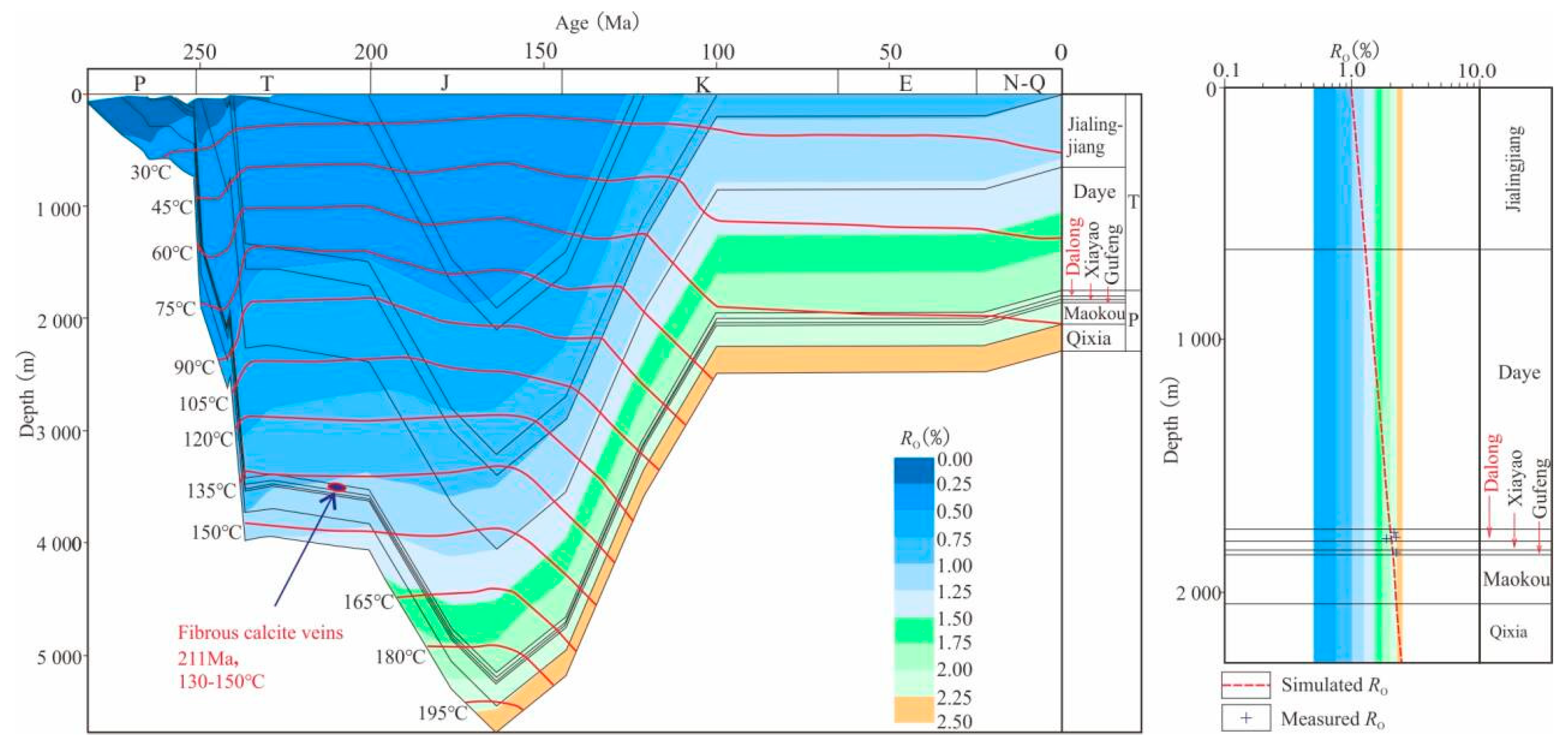

| Samples | Mg | Mn | Fe | Mn/Fe | Sr | Sc | La | Ce | Pr | Nd | Sm | Eu | Gd | Tb | Dy | Ho | Er | Tm | Yb | Lu | ΣREE | δEu | δCe | L/H |
|---|---|---|---|---|---|---|---|---|---|---|---|---|---|---|---|---|---|---|---|---|---|---|---|---|
| JS2-1 | 2502.98 | 875.11 | 379.45 | 2.31 | 11,583.28 | 4.90 | 3.75 | 13.92 | 3.16 | 16.22 | 4.10 | 1.23 | 4.30 | 0.73 | 4.55 | 0.93 | 2.45 | 0.31 | 1.79 | 0.22 | 57.65 | 1.28 | 0.74 | 0.51 |
| JS2-2 | 2280.77 | 1177.66 | 402.04 | 2.93 | 9580.75 | 4.34 | 1.06 | 5.08 | 1.51 | 8.76 | 2.79 | 0.64 | 2.69 | 0.55 | 3.59 | 0.74 | 2.09 | 0.28 | 1.84 | 0.24 | 31.86 | 1.02 | 0.62 | 0.33 |
| JS2-3 | 2359.75 | 805.11 | 475.53 | 1.69 | 10,766.03 | 7.80 | 1.18 | 7.64 | 2.55 | 15.89 | 4.42 | 1.13 | 4.66 | 0.81 | 5.75 | 1.23 | 3.48 | 0.49 | 3.09 | 0.41 | 52.73 | 1.09 | 0.58 | 0.33 |
| JS2-4 | 1898.93 | 551.29 | 426.25 | 1.29 | 9147.38 | 3.69 | 0.69 | 5.51 | 2.25 | 14.89 | 3.78 | 1.07 | 3.99 | 0.73 | 4.77 | 0.98 | 2.58 | 0.33 | 2.00 | 0.26 | 43.82 | 1.21 | 0.49 | 0.39 |
| JS2-5 | 1529.51 | 452.38 | 341.38 | 1.33 | 6922.97 | 3.29 | 0.58 | 4.93 | 1.99 | 11.48 | 2.73 | 0.77 | 2.61 | 0.46 | 2.82 | 0.56 | 1.46 | 0.20 | 1.16 | 0.17 | 31.92 | 1.26 | 0.50 | 0.49 |
| JS2-6 | 1752.42 | 476.69 | 220.70 | 2.16 | 10,456.50 | 4.82 | 2.46 | 27.44 | 8.34 | 43.17 | 7.73 | 1.41 | 6.39 | 1.03 | 5.98 | 1.10 | 2.68 | 0.32 | 1.95 | 0.24 | 110.25 | 0.88 | 0.66 | 0.75 |
| JS2-7 | 1305.08 | 336.04 | 138.71 | 2.42 | 2433.59 | 0.90 | 12.34 | 39.97 | 7.80 | 34.34 | 4.42 | 1.35 | 2.27 | 0.26 | 1.39 | 0.26 | 0.60 | 0.07 | 0.38 | 0.05 | 105.48 | 1.79 | 0.80 | 2.73 |
| JS2-8 | 1892.27 | 472.74 | 323.30 | 1.46 | 7866.40 | 0.75 | 0.13 | 1.24 | 0.39 | 2.27 | 0.70 | 0.18 | 0.75 | 0.13 | 0.77 | 0.15 | 0.42 | 0.06 | 0.32 | 0.04 | 7.55 | 1.11 | 0.64 | 0.41 |
| JS2-9 | 1304.74 | 370.07 | 166.99 | 2.22 | 9135.67 | 1.95 | 1.57 | 8.91 | 2.01 | 9.68 | 2.53 | 0.75 | 2.46 | 0.37 | 2.19 | 0.41 | 1.04 | 0.13 | 0.74 | 0.10 | 32.89 | 1.32 | 0.80 | 0.65 |
| JS2-10 | 1643.00 | 414.09 | 343.33 | 1.21 | 8473.98 | 4.49 | 1.86 | 10.39 | 2.44 | 11.91 | 2.92 | 1.29 | 2.85 | 0.44 | 2.85 | 0.57 | 1.48 | 0.20 | 1.25 | 0.17 | 40.62 | 1.97 | 0.78 | 0.66 |
| JS2-11 | 2301.20 | 583.63 | 444.07 | 1.31 | 12,802.77 | 6.43 | 3.28 | 16.45 | 3.84 | 18.47 | 4.73 | 2.32 | 4.88 | 0.79 | 4.95 | 1.04 | 2.82 | 0.37 | 2.20 | 0.29 | 66.43 | 2.11 | 0.77 | 0.62 |
| JS2-12 | 2538.09 | 1133.62 | 555.37 | 2.04 | 13,384.79 | 5.46 | 3.07 | 15.04 | 3.38 | 16.47 | 4.69 | 2.35 | 4.43 | 0.75 | 4.67 | 0.99 | 2.69 | 0.33 | 2.13 | 0.27 | 61.25 | 2.26 | 0.79 | 0.64 |
| JS2-13 | 2825.53 | 1025.52 | 459.23 | 2.23 | 13,631.29 | 4.66 | 4.65 | 18.07 | 3.87 | 19.45 | 5.36 | 3.12 | 5.15 | 0.85 | 5.28 | 1.05 | 2.79 | 0.34 | 2.02 | 0.26 | 72.28 | 2.60 | 0.78 | 0.74 |
| JS2-14 | 2676.19 | 938.42 | 389.08 | 2.41 | 14,152.38 | 5.19 | 4.49 | 15.79 | 3.25 | 16.91 | 5.25 | 2.73 | 5.46 | 0.94 | 6.05 | 1.25 | 3.41 | 0.45 | 2.66 | 0.35 | 69.01 | 2.23 | 0.78 | 0.56 |
| JS2-15 | 2567.40 | 636.05 | 359.54 | 1.77 | 12,157.07 | 3.20 | 5.53 | 16.04 | 3.01 | 15.24 | 4.44 | 2.38 | 4.32 | 0.73 | 4.60 | 0.98 | 2.57 | 0.33 | 1.89 | 0.25 | 62.30 | 2.39 | 0.79 | 0.66 |
| JS4-1 | 1590.88 | 873.53 | 213.91 | 4.08 | 9049.35 | 6.57 | 0.94 | 11.33 | 4.40 | 27.15 | 7.95 | 1.23 | 7.35 | 1.42 | 9.52 | 2.15 | 6.42 | 0.97 | 7.11 | 1.07 | 89.01 | 0.71 | 0.53 | 0.26 |
| JS4-2 | 1905.74 | 559.78 | 132.15 | 4.24 | 3527.20 | 2.07 | 1.76 | 11.08 | 3.17 | 21.72 | 8.42 | 1.30 | 7.43 | 1.14 | 7.19 | 1.40 | 3.80 | 0.50 | 3.48 | 0.47 | 72.86 | 0.72 | 0.67 | 0.40 |
| JS4-3 | 2119.48 | 521.06 | 133.42 | 3.91 | 3361.22 | 2.13 | 2.06 | 11.04 | 2.94 | 20.25 | 9.58 | 1.61 | 6.97 | 1.01 | 5.95 | 1.14 | 2.90 | 0.38 | 2.47 | 0.33 | 68.62 | 0.86 | 0.69 | 0.54 |
| JS4-4 | 1318.63 | 450.65 | 129.68 | 3.48 | 2553.61 | 3.98 | 3.22 | 16.58 | 4.36 | 29.42 | 13.13 | 1.98 | 8.61 | 1.27 | 7.45 | 1.42 | 3.84 | 0.53 | 3.62 | 0.53 | 95.95 | 0.80 | 0.70 | 0.55 |
| JS4-5 | 1609.87 | 422.89 | 128.77 | 3.28 | 3676.01 | 2.73 | 1.91 | 9.38 | 2.62 | 17.61 | 9.77 | 1.82 | 6.51 | 0.91 | 5.65 | 1.05 | 2.79 | 0.37 | 2.55 | 0.35 | 63.29 | 0.99 | 0.66 | 0.57 |
| JS4-6 | 1367.65 | 433.95 | 128.49 | 3.38 | 2081.09 | 3.63 | 2.56 | 12.03 | 3.22 | 21.09 | 9.37 | 1.45 | 5.91 | 0.85 | 5.14 | 1.02 | 2.80 | 0.42 | 2.98 | 0.44 | 69.28 | 0.84 | 0.68 | 0.54 |
| JS4-7 | 2058.32 | 482.05 | 141.59 | 3.40 | 2950.54 | 0.20 | 0.42 | 2.31 | 0.62 | 4.14 | 1.60 | 0.48 | 1.43 | 0.19 | 1.17 | 0.20 | 0.47 | 0.06 | 0.33 | 0.04 | 13.46 | 1.38 | 0.69 | 0.68 |
| JS4-8 | 1292.03 | 425.90 | 120.47 | 3.54 | 1794.43 | 4.87 | 4.14 | 18.23 | 4.67 | 27.17 | 9.03 | 1.71 | 7.03 | 1.05 | 6.13 | 1.20 | 3.30 | 0.46 | 3.30 | 0.49 | 87.90 | 0.94 | 0.69 | 0.54 |
| JS4-9 | 2877.58 | 539.08 | 131.83 | 4.09 | 2102.57 | 2.95 | 1.91 | 7.53 | 1.75 | 10.44 | 4.72 | 1.15 | 4.89 | 0.77 | 4.80 | 0.92 | 2.51 | 0.33 | 2.09 | 0.30 | 44.12 | 1.05 | 0.73 | 0.39 |
| JS4-10 | 1440.04 | 425.80 | 121.40 | 3.51 | 2191.94 | 4.54 | 6.34 | 21.97 | 4.75 | 28.04 | 10.57 | 2.11 | 8.85 | 1.36 | 8.01 | 1.52 | 3.92 | 0.56 | 3.63 | 0.55 | 102.16 | 0.96 | 0.75 | 0.51 |
| JS4-11 | 1373.49 | 447.66 | 132.40 | 3.38 | 1978.88 | 6.53 | 6.31 | 24.53 | 5.45 | 30.77 | 11.54 | 2.09 | 9.04 | 1.39 | 8.49 | 1.63 | 4.55 | 0.64 | 4.41 | 0.65 | 111.49 | 0.90 | 0.76 | 0.50 |
| JS4-12 | 1214.38 | 427.67 | 137.37 | 3.11 | 1757.29 | 4.91 | 3.81 | 17.22 | 4.26 | 25.30 | 7.83 | 1.32 | 6.52 | 1.00 | 6.05 | 1.22 | 3.41 | 0.50 | 3.50 | 0.55 | 82.49 | 0.81 | 0.72 | 0.46 |
| JS4-13 | 1330.34 | 399.23 | 129.37 | 3.09 | 2858.08 | / | 0.28 | 1.44 | 0.38 | 2.67 | 0.87 | 0.24 | 0.79 | 0.12 | 0.67 | 0.12 | 0.27 | 0.03 | 0.16 | 0.01 | 8.04 | 1.30 | 0.70 | 0.69 |
| JS4-14 | 2712.09 | 517.85 | 125.01 | 4.14 | 2314.07 | / | 0.28 | 1.63 | 0.50 | 3.46 | 1.50 | 0.26 | 0.97 | 0.15 | 0.90 | 0.18 | 0.44 | 0.05 | 0.30 | 0.03 | 10.65 | 0.93 | 0.62 | 0.61 |
| JS4-15 | 2749.68 | 571.37 | 166.27 | 3.44 | 3734.29 | 0.68 | 0.16 | 1.16 | 0.39 | 3.03 | 1.43 | 0.38 | 1.64 | 0.25 | 1.76 | 0.33 | 0.91 | 0.11 | 0.76 | 0.10 | 12.43 | 1.09 | 0.59 | 0.33 |
| JS4-16 | 1080.03 | 431.34 | 130.84 | 3.30 | 2329.53 | 2.61 | 2.84 | 14.70 | 3.69 | 21.16 | 5.43 | 0.82 | 4.32 | 0.75 | 4.51 | 0.90 | 2.61 | 0.39 | 2.75 | 0.42 | 65.30 | 0.75 | 0.72 | 0.45 |
| Sample | No. | δ13CV-PDB (‰) | δ18OV-PDB (‰) | δ18OV-SMOW (‰) | ∆ |
|---|---|---|---|---|---|
| JS2 | 1 | −4.30 | −6.55 | 24.17 | 28.62 |
| 2 | −4.29 | −6.64 | 24.07 | 28.57 | |
| 3 | −4.30 | −6.63 | 24.08 | 28.61 | |
| 4 | −4.08 | −6.75 | 23.97 | 27.88 | |
| 5 | −2.38 | −6.46 | 24.26 | 22.01 | |
| 6 | −3.42 | −6.52 | 24.20 | 25.59 | |
| 7 | −3.51 | −6.41 | 24.31 | 25.89 | |
| 8 | 2.96 | −6.43 | 24.29 | 3.60 | |
| 9 | 2.84 | −6.77 | 23.94 | 4.01 | |
| 10 | 2.72 | −7.10 | 23.60 | 4.41 | |
| 11 | 3.16 | −6.76 | 23.95 | 2.90 | |
| 12 | 3.39 | −6.59 | 24.13 | 2.11 | |
| 13 | 3.10 | −7.05 | 23.65 | 3.09 | |
| 14 | 1.71 | −6.97 | 23.73 | 7.90 | |
| 15 | −4.06 | −6.78 | 23.93 | 27.80 | |
| 16 | −4.50 | −6.90 | 23.81 | 29.32 | |
| 17 | −4.52 | −6.97 | 23.74 | 29.38 | |
| 18 | −4.53 | −6.73 | 23.98 | 29.43 | |
| 19 | −4.44 | −7.13 | 23.57 | 29.09 | |
| 20 | −4.38 | −7.19 | 23.51 | 28.89 | |
| JS4 | 1 | 2.48 | −7.43 | 23.26 | 5.23 |
| 2 | 2.41 | −7.24 | 23.46 | 5.49 | |
| 3 | 2.99 | −7.39 | 23.30 | 3.49 | |
| 4 | 3.37 | −7.27 | 23.43 | 2.18 | |
| 5 | 3.64 | −7.16 | 23.54 | 1.25 | |
| 6 | 3.87 | −7.43 | 23.26 | 0.46 | |
| 7 | 3.42 | −6.99 | 23.71 | 1.98 | |
| 8 | 3.82 | −7.30 | 23.39 | 0.63 | |
| 9 | 3.95 | −7.85 | 22.83 | 0.16 | |
| 10 | 3.86 | −7.28 | 23.42 | 0.48 | |
| 11 | 3.53 | −7.69 | 22.99 | 1.63 | |
| 12 | 3.04 | −7.34 | 23.35 | 3.32 | |
| 13 | 2.54 | −7.02 | 23.68 | 5.03 |
Disclaimer/Publisher’s Note: The statements, opinions and data contained in all publications are solely those of the individual author(s) and contributor(s) and not of MDPI and/or the editor(s). MDPI and/or the editor(s) disclaim responsibility for any injury to people or property resulting from any ideas, methods, instructions or products referred to in the content. |
© 2025 by the authors. Licensee MDPI, Basel, Switzerland. This article is an open access article distributed under the terms and conditions of the Creative Commons Attribution (CC BY) license (https://creativecommons.org/licenses/by/4.0/).
Share and Cite
Liu, A.; Chen, L.; Jiang, S.; Li, H.; Zhang, B.; Cai, Y.; Zhang, J.; Wei, W.; Xia, F. Petrographic and Geochemical Insights from Fibrous Calcite Veins: Unraveling Overpressure and Fracture Evolution in the Upper Permian Dalong Formation, South China. Minerals 2025, 15, 896. https://doi.org/10.3390/min15090896
Liu A, Chen L, Jiang S, Li H, Zhang B, Cai Y, Zhang J, Wei W, Xia F. Petrographic and Geochemical Insights from Fibrous Calcite Veins: Unraveling Overpressure and Fracture Evolution in the Upper Permian Dalong Formation, South China. Minerals. 2025; 15(9):896. https://doi.org/10.3390/min15090896
Chicago/Turabian StyleLiu, An, Lin Chen, Shu Jiang, Hai Li, Baomin Zhang, Yingxiong Cai, Jingyu Zhang, Wei Wei, and Feiyong Xia. 2025. "Petrographic and Geochemical Insights from Fibrous Calcite Veins: Unraveling Overpressure and Fracture Evolution in the Upper Permian Dalong Formation, South China" Minerals 15, no. 9: 896. https://doi.org/10.3390/min15090896
APA StyleLiu, A., Chen, L., Jiang, S., Li, H., Zhang, B., Cai, Y., Zhang, J., Wei, W., & Xia, F. (2025). Petrographic and Geochemical Insights from Fibrous Calcite Veins: Unraveling Overpressure and Fracture Evolution in the Upper Permian Dalong Formation, South China. Minerals, 15(9), 896. https://doi.org/10.3390/min15090896






